TL;DR
- ETH2.0 is a phased release
- Current merge is only a PoW to PoS move
- PoS’s primary benefit: No more energy wasted by uncle blocks
- Planned for 2023: Sharding
- Sharding is likely to have a huge impact on our development practices
- Finally: Notes from Consensus 2022 in Austin, Texas (Read below)
Ethereum, the most popular blockchain platform, has been planning a major software update for a long while. This update is known as ETH2.0.
There are a 1000+ articles on what and why about this ETH2.0, but after scanning through them for a day, we figured the current state of our understanding was ‘unconfirmed’. If you are in the same boat, then welcome to our dumb-friendly and easy-to-get-a-grip article on ETH2.0.
PoW to PoS (you already knew about this)
We are quite confident that you already know that ETH2.0 is a transition from a proof-of-work consensus mechanism to a proof-of-stake model. A quick refresher:
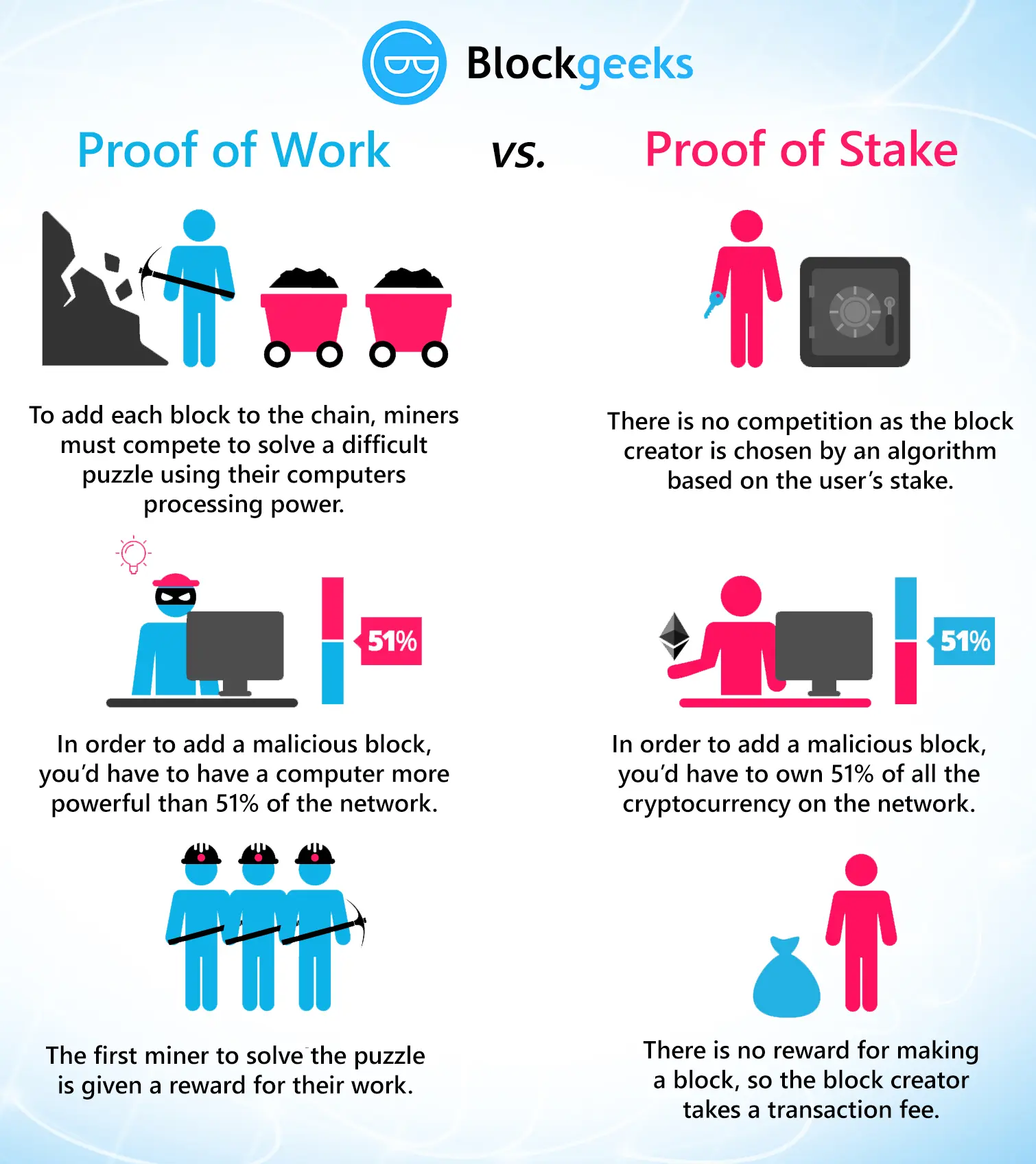
With the ground zero set-up; let's understand:
- about the Merge
- why it is such a big deal for Web3 space, and
- most importantly why should you care about this at all
How does Ethereum work currently?
We all know that the current Ethereum Mainnet runs on the proof-of-work, aka PoW architecture; this is the same as the other largest blockchain network BitCoin. To not bore you to death, we are skipping the nuances of PoW and focusing on the most important lesson learned from PoW:
As the number of transactions in the blockchain increase, the computational power required to confirm the transactions also increases, which leads to higher power consumption.
While you will read almost everywhere that this “HIGH” energy consumption is ‘the’ problem, we will shout out loud that NO, it is not ‘the’ problem (unpopular opinion). ‘The’ main issue is the uncle blocks. Now again, we are choosing to not bore you to death with the nuance of uncle blocks, but cutting the story to the point:
Uncle blocks (or Ommer) are created when two or more miners create blocks at nearly the same time. Only one block can be mined and accepted as canonical on the blockchain. The others are uncle blocks, which are not included but still provide a reward to their miners for the work done
source: https://info.etherscan.com/
In short, these ‘mining’ efforts are “wasted”. Let us repeat this: “wasted”.
It is the energy consumption in the rat race of mining that is ‘the’ energy guzzler.
Now that we have understood the villain in the story. Let's introduce the hero: ETH 2.0 or The Merge. 🦸
I know what ETH2.0 is; tell me something that I do not know! 🙀
- Main: Energy efficiency, less computational work = less energy used (our knight in shining armor)
- Others: Lower barriers to entry (that’s not to say that just anyone can be a validator, but it is better)
- Others: Reduced centralization, tied in with the last point, easier entry means higher decentralization
- Others: Security is increased as 51% of attacks are more expensive
Power Ranger
Currently, Ethereum uses 113 terawatt-hours of electricity per year. That is as much as what the Netherlands consumes in a year.
According to Digiconomist, a single Ethereum transaction can consume as much power as an average US household uses in more than a week.
This has become a huge concern for the people as it has started showing its impact on the environment.
Power Power Power!

It is estimated the PoS will use 99.5% less energy than PoW.
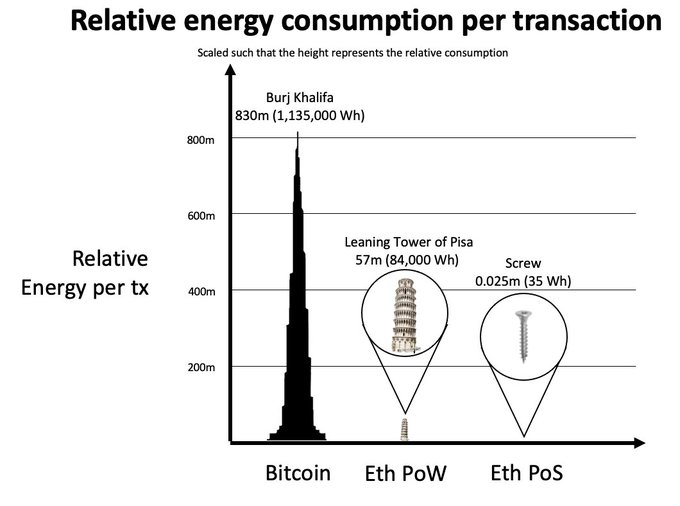
That is it; literally, that is the BIGGEST benefit of the merge that happened on Ropsten. See here 👉 Link+
Wait a minute, there were so many other things that I read, was I cheated?
No. You were not.
ETH2.0 is a colloquial term and is used to represent one more BIG change: Sharding. Sharding is a technically heavy topic. In a one-liner, sharding is the ability to run a “chain of chains”. Zilliqa (based on our limited knowledge) was the first blockchain to execute sharding.
Try to bask in the light of this image to imagine how sharding looks like
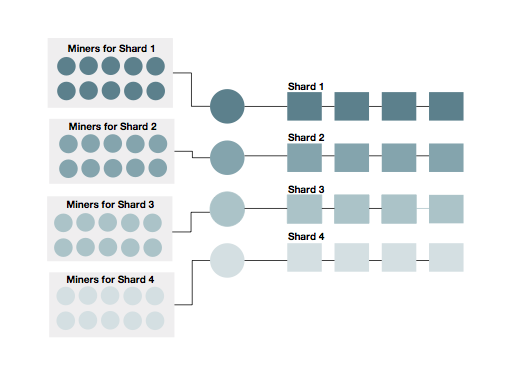
source: Link
So what is the status of sharding?
Being your friend, we suggest you do not hold your breath for this. This is planned for somewhere in 2023.
Should I care about sharding?
Yes. Sharding is expected to have a huge impact on our development practices. So keep an eye out for that.
Benefits of sharding?
- Higher throughput: which means the time taken to process transactions will be way lesser than the current 13 secs (average)
- Reduction in Gas Costs
Impact of ETH2.0 on Mining and Markets
We all know that mining is an income generation venue. At present, a miner gets 2 ether per block plus all the priority fees contained in the block. Based on our research we found that per day the number of ETH mined and provided to miners is north of 12,000+ ETH.
On the basis that all of this ETH arrives at the exchanges for liquidation, there will be sell pressure every single day.
Based on this source:
We require around $10M of new money every day to keep the price flat. Therefore, after the Merge, the value will be reduced to $8M for existing holders to sell their ETH to prevent the price from going up.
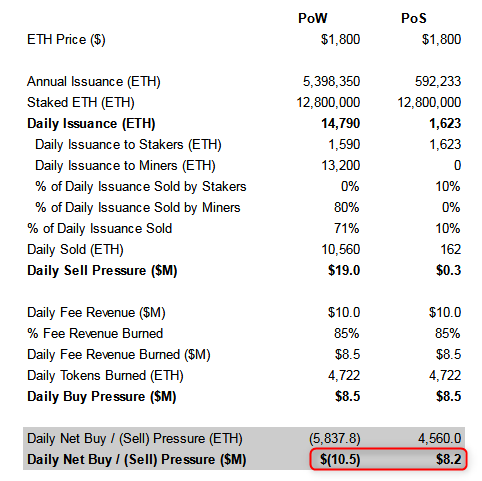
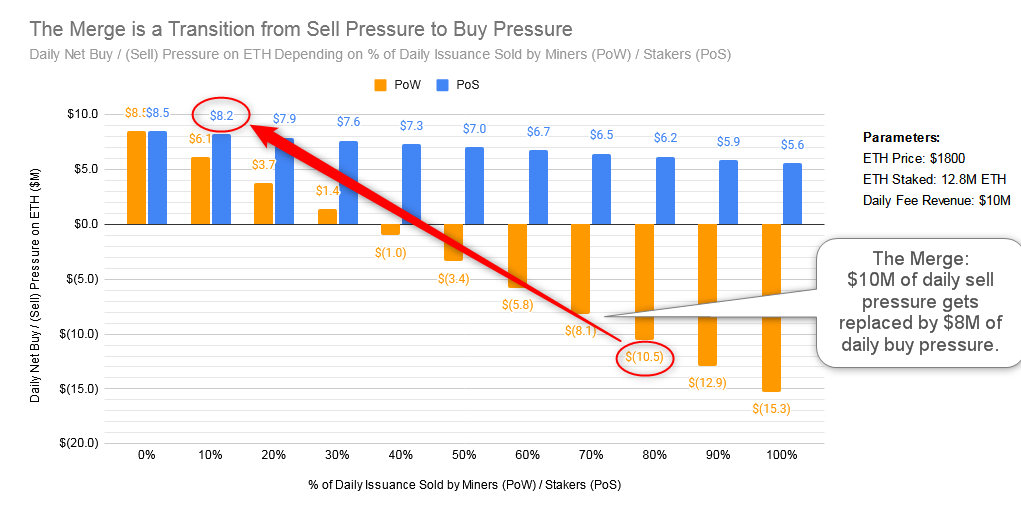
Thank you again Korpi for this insight.
As a Web3 developer, what impacts me?
The current PoW to PoS has minimal impact. The block time is expected to be shortened from 13 seconds per block to 12 seconds.
As a result, smart contracts that use block production speed as a measure of time will run one second faster after the Merge takes place.
Is that it?
No. Read the sharding portion above again. With sharding, a lot of changes are expected. But we just don’t know what all of these are yet.
What does this change mean for the newcomers?
For the newcomers to this space, this represents the best opportunity to jump in and start participating.
It’ll be cheaper to start a DAO or launch a project. Or, if you’re more interested in contributing to the network as a validator, the new mechanism is making it even easier for you to participate with reduced hardware requirements.
If you were concerned about the environmental impact of blockchain technologies, the reduced impact of the second-largest blockchain in existence is being cut so you can feel maybe a twinge less guilty about using it (if you’re in the category you should also check out this article).
Or, if you’re a security skeptic then maybe you might be feeling unsure about this. After all, PoS is less tested under the heat of battle than PoW.
On the other hand, ETH 2.0 was designed with security at the forefront of consideration; requiring a minimum of 16,384 validators, Vitalik is pretty confident in it as well.
This number of validators certainly seems like it’s enough to adequately call it decentralized and the cost of a 51% attack against the network would cost many billions of dollars in staked ETH.
Notes from Consensus 2022 in Austin, Texas
Members of the core team that were at Consensus 2022 participated in a panel about the ETH merge and I was able to pull two major areas to highlight from this.
First, regarding the frustrations voiced over the continual setbacks in finalizing the merge, the team pressed on the need for patience as research takes time to conduct and test. With security and stability being vital to the success of the merge, the team is taking the precautions necessary. If something does go wrong during the merging process the team will stop the merge and postpone it again.
Secondly, when the issue of centralization was pressed the team responded that the update will effectively break up the Ethereum mining cartels that have dominated the market, leading to greater decentralization. Further, staked ETH centralization is a problem that will need to be solved by a combination of human and technical methods. Every layer of the ecosystem will have to continue to grow to mitigate the centralization of ETH.
Authors (open to feedback): 👇
